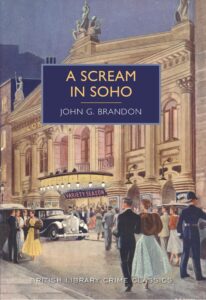 It’s London in wartime, in the blackout before the Blitz and the streets of Soho are full of characters straight out of central casting.
It’s London in wartime, in the blackout before the Blitz and the streets of Soho are full of characters straight out of central casting.
Our protagonist is Scotland Yard’s Detective Inspector Patrick Aloysius McCarthy, a hard-boiled cop with an Irish father and a Neopolitan mother and all the stereotypical traits of both. He’s prone to hunches and the luck of the Irish. He moves easily through the world of Irish thugs and Italian gangsters and speaks with a “top o’ the morning to ye” brogue. He’s tough and streetwise and he knows the dark heart and narrow streets of Soho because he grew up in them.
As a cop, he makes and breaks the rules, is handy with his fists, and is not afraid to use them. He even gets along with his superior at the Yard – Assistant Commissioner of Police Sir William Haynes – whose attitude to his underling seems awestruck and deferential. Haynes treats McCarthy to a fancy lunch at Verrey’s on Regent Street where the beautiful Baroness Lena Eberhardt is a regular.
Is she a political refugee from Mittel Europe? Or a Nazi spy? Yes – this is 1940 and there have to be spies.
This 1920 painting of Verrey’s by Charles Moresco Pearce could almost depict a key scene from the novel. It’s even called “Conspiracy”.
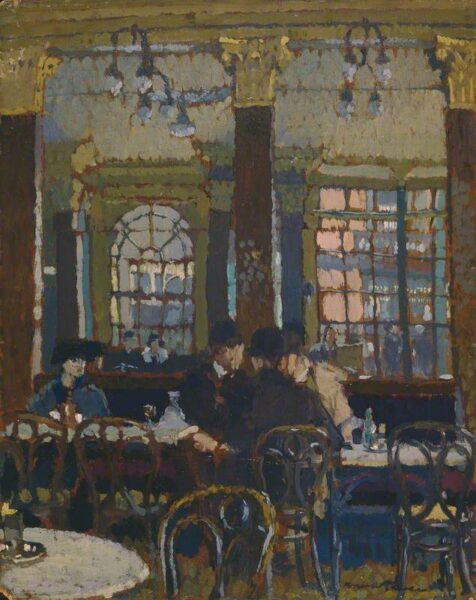
A handy supporting cast of colorful and convenient locals includes petty thief Danny the Dip and taxi driver “Big Bill” Withers. Naturally, Bill speaks like a cockney and this has to be carefully rendered so we get the idea of what kind of a bloke he is.
“Well, it’s this way, sir, an’ I ain’t makin’ no excuses for meself. I was just makin’ for Soho Square to come in by Greek Street, when a bleeder wiv a big car come slashin’ out into Oxford Street wiv no lights on, takes the corner on two wheels and all-but rams me proper. He gave my mudguards a dam’ good rakin’ — ow e didn’t take ’em off is more than I know. Take a mike at ’em, guv ’nor, an’ you’ll see as ’ow I ain’t tellin’ no lies — th’ dirty arsterbar!”
There are any number of thoroughly nasty foreigners, immigrants, and locals plus some with a heart of gold. There are goodies like Lucia Spadoglia who owns the Cafe Milano and baddies like Signor Floriello Mascagni who hangs around race tracks by day and sleazy clubs by night. There’s the extremely villainous, Signor Luigi Fasoli, who runs the dirtiest wine shop in Soho with the grandiloquent name of the Circolo Venezia. There are cut-throat Jewish gangsters and fences like Mo Eberstein into protection rackets and gambling scams.
There’s a mysterious man with blank, ice-blue eyes, (could he be a villain? a foreigner? You be the judge), a corpse unaccountably dressed in women’s clothes, and a sinister and totally amoral dwarf. It’s all go.
There are plenty of dead bodies, throat-slitting with stiletto knives, no-holds-barred brawls, and pools of blood. This is not a St Mary Mead cosy.
The Scream in the Black-Out
The story begins with a scream.
Opinions in that particular portion of Soho in which the crime was committed differed as to the exact quality of the terrible scream that rang out at five minutes past one, precisely. Police Constable C. 1285, working a Soho beat, part of which forced him to inch himself through the gloom from Oxford Street the length of Dean Street to Shaftesbury Avenue, was positive that it came from the throat of a woman; anyhow, it stopped him dead. For a scream in the early hours of the morning in Soho, even from a female throat, to stop dead in his tracks a hard- boiled constable who had worked in that cosmopolitan quarter for years, had to be something entirely out of the ordinary, as, indeed, this one was!
There’s the evidence of a crime – the knife, the blood. But no body. There’s a lingering smell of a powerful perfume preposterously providing McCarthy with important clues. As the plot unfolds there are more murders plus German agents getting their hands on Britain’s recently stolen air defense plans.
The best character in the book is Soho itself and the recognizable names of streets and places. This from another source is Verrey’s in Regent Street – a place to see and be seen:
It had dark green panels and small square tables with red-shaded candles. The ceiling had silver arches and there were so many mirrors on the walls that diners were reflected multiple times. One restaurant critic, Nathaniel Newnham-Davis, called it a ‘rendezvous of the more aristocratic foreign visitors to London’, making it sound like something out of a Henry James novel. Newnham-Davis wrote that Mrs Myra Washington dined there, an American who knew ‘most people who are worth knowing in Europe’. As she sat at her table, her ‘cream-coloured miracle of a dress’ was reflected in all the mirrors. https://www.lrb.co.uk/the-paper/v41/n16/bee-wilson/mmmm-chicken-nuggets
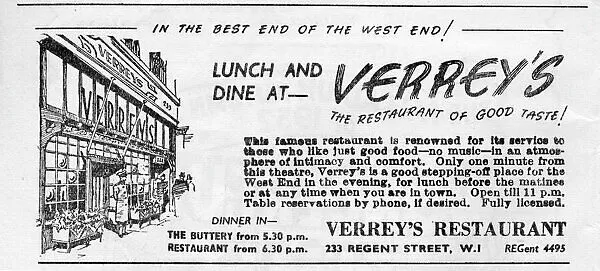
While Haynes and Mccarthy are at lunch, there’s a mysterious knock at the cafe window – is it a signal from the gangster Mascagni to the beautiful Baroness? When she leaves Verrey’s, Withers is assigned to follow her. And we are off on a little tour of the neighborhood.
Did he have any luck, McCarthy asks, and Withers gives his report:
A note of dubiousness promptly entered into the taxi- man’s voice.
“That all depends as the way that y’ look at it, guv’nor,” he replied. “Any’ow, ere’s what ’appened. She come out of Verrey’s and ’is ’Igh … I mean Sir William, was wiv ’er, like you said. F’r a minnit I thought ’e’d spotted me and was goin’ to call me up, but ’e didn’t. He shakes ’ands wiv ’er, and goes off along Regent Street towards Piccadilly. She crossed the road to Liberty’s corner and stands lookin’ at the winders for a bit. She kep’ a-lookin’ arter ’im now and agin, and then she ’ails a taxi, and . . .”
“Just a minute, Withers. She kept looking after Sir William, you say ? Did it strike you, by any chance, that she might have been keeping an eye on him to see that he really was well out of her way?”
“Well, sir, in a sort of a kind of a way, that’s jest wot I did think. Any’ow, she gits in this taxi, and turns east at Oxford Street as far as Charing Cross Road. Then she turns into Soho Square and goes right round it, slow-like, and out agin by Greek Street.”
“Didn’t stop anywhere at all?” McCarthy asked, perplexedly.
“No, guv ’nor, she never stopped nowhere. She goes down Greek Street like I said, then turns into Dean Street. At a tobacconists, just a bit above your crib and on the other side of the street, she pulls up and goes in. That German bloke’s place; Kirchner, I think the name is.”
Go on, Withers,” McCarthy encouraged. “This is very interesting.”
“She musta bought some cigarettes, or summink there, becos when she come out she ’ad a packet in ’er ’and. Afore she gets back into the taxi I see ’er givin’ your place a real once over — if you’d ’appened to ’a’ bin lookin’ aht of the winder, you couldn’t ’a’ ’elped seein’ ’er. Then off she goes round agin into Greek Street — and that’s where I lost ’er.”
“Lost her,” McCarthy echoed. *
“Yus, guv’nor, she gimme the shake right enough; no good sayin’ anythink else.”
“Just at what point did you lose her, Withers?” McCarthy asked puzzledly. For anyone to give “Big Bill” Withers the slip in Soho meant that they knew that cosmopolitan portion of the metropolis thoroughly; no-one not thoroughly acquainted with its many alleys and short cuts, generally, could have possibly accomplished it. “For a lady who resides in Grosvenor Square and is one of the elect, that’s rather unusual isn’t it, Withers?”
Unusual indeed. And clearly, this Baroness is not what she seems.
Two decades before McCarthy meets the Baroness at Verrey’s, Charles Pierce painted it.
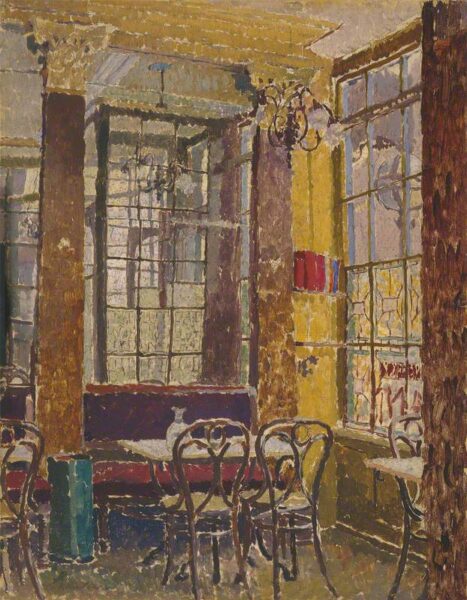
Corner of Cafe Verrey; by Charles Maresco Pearce
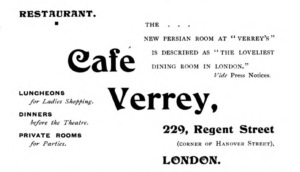 Here’s another advertisement for Verrey’s which was founded by a German c.1850, served French food, and was patronized by Dickens and Tennyson.
Here’s another advertisement for Verrey’s which was founded by a German c.1850, served French food, and was patronized by Dickens and Tennyson.
All of this of course has nothing but a passing connection with A Scream in Soho but one book led to to another, as is always the way.
This is from the 1897 Jubilee edition of Charles Eyre Pascoe’s. London of to-day. An illustrated handbook for the season
It’s a travel guide for well-heeled Americans in London and it’s absolutely stuffed with great period details. If you’re ever writing about fashionable late Victorian London this would be an invaluable resource.
This is how he describes Verrey’s
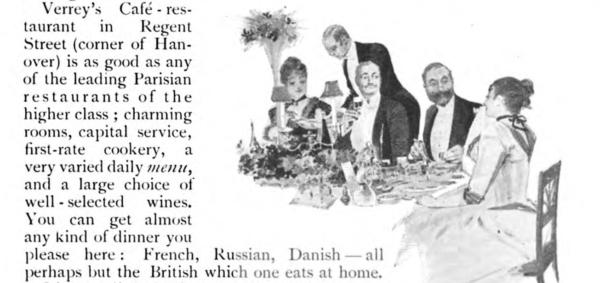
This is what Lieut.-Col. Newnham-Davis had for dinner at Verrey’s in 1899
Petite marmite.
OEufs à la Russe.
Soufflé de filets de sole à la Verrey.
Timbale Lucullus.
Noisettes d’agneau à la Princesse.
Petits pois à la Française.
Pommes Mirelle.
Aiguillettes de caneton à l’Orange.
Salade Vénétienne.
Pouding Saxon.
Salade de fruits.
This is the menu of a dinner at which H.R.H. the Prince of Wales was present
OEufs à la Kavigote
(Vodkhi)
Bisque d’écrevisses. Consommé Okra
Rougets à la Muscovite
Selle de mouton de Galles
Haricots panachés. Tomates au gratiri
Pommes soufflées
Timbale Lucullus
Fonds d’artichauts. Crème pistache
Grouse
Salad Rachel
Biscuit glacé à la Verrey
Soufflé de laitances
Dessert
And if you want to make Timbales à la Lucullus at home, here’s the recette
TIMBALE LUCULLUS
La garniture Lucullus se compose de: crétes de coq, rognons de coq, truffes en lames, quenelles de volaille truffées, champignons, foie gras dans une demi-glace bien reduite, un filet de madère, et un jus de truffes.
The Lucullus garnish is composed of cocks’ combs, cocks’ kidneys, truffles cut in slices, chicken quenelles, made with truffles, mushrooms, foie-gras well stewed down in a semi-liquid glaze,1 with just a suspicion of Madeira, and a gravy made from truffles.
1Or a glaze which has not been boiled down so as to make it a very stiff jelly.
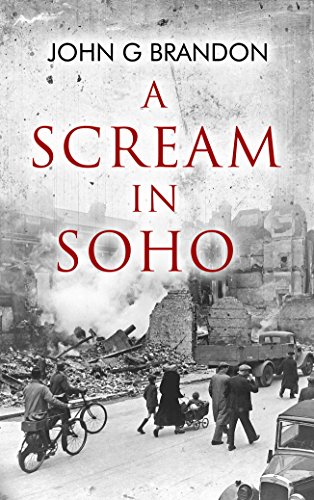 The British Library Crime Classics reprint edition of Scream features the London Palladium Theatre, program cover, Variety Season, Autumn 1952. That makes more sense that this cover on the Sharpe Books edition which features a photo of a bombed-out street in London.
The British Library Crime Classics reprint edition of Scream features the London Palladium Theatre, program cover, Variety Season, Autumn 1952. That makes more sense that this cover on the Sharpe Books edition which features a photo of a bombed-out street in London.
Brandon’s book is set during the blackout and was first published in 1940 but the murder and mayhem all take place before the Blitz began. It helps when book jacket designers and publishers have at least a passing familiarity with the content.
I read this book for the #1940Club hosted by Simon of Stuck in a Book and Karen of Kaggsy’s Bookish Ramblings. It’s one of several I never got around to writing about. So now I have.
If you can get beyond the stereotypes and prejudices and don’t mind violence, gore, dastardly villains, ruthless foreign agents, and cartoon characters, then you might enjoy the atmospheric tour of Soho’s seedy streets.
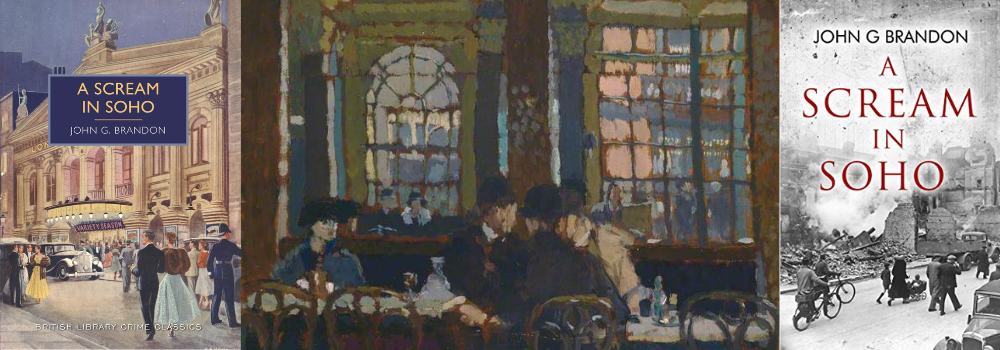


What a fabulous post and sounds a stonker of a book!
Half stonker. Half stinker. But a good period read.
I wants ta reed dis ting bout olde town. By the way, what the h is a ” selle de mouton “– I hope it’s not what I imagined it might be.
It’s saddle of mutton. You know – one of your favorite things especially when served with a fishy appetizer and stonking great salad.
Look – cover it with enough mint sauce and no one knows what it is.
The ‘Conspiracy’ painting is wonderfully perfect here and I’m charmed by the ‘suspicion of Madeira’ in that recipe.
It’s the best! Worthy of the genre of those martini recipes that say things like “introduce” the vermouth to the gin.
It’s a while since I read this one, though I do recall enjoying it a lot, despite the issues with it being from that era. Certainly the setting was great!
It seems like a mix of several books I have recently read of the same time period, but perhaps with a little more action and colourful characters!